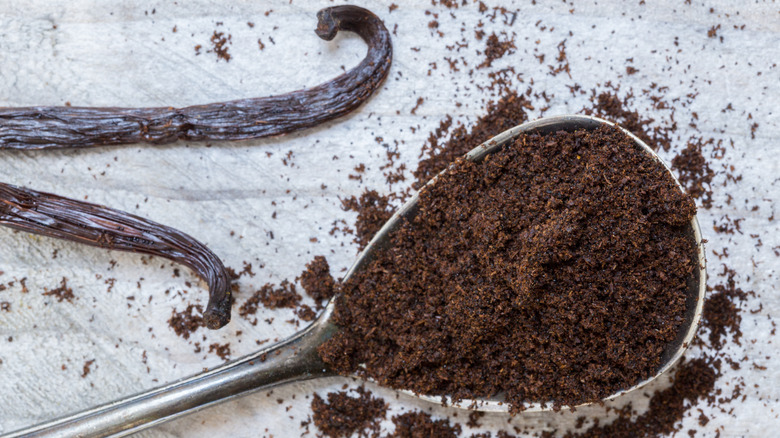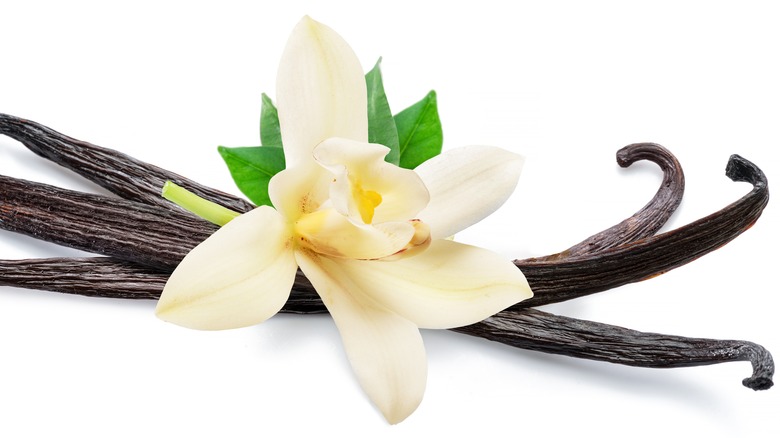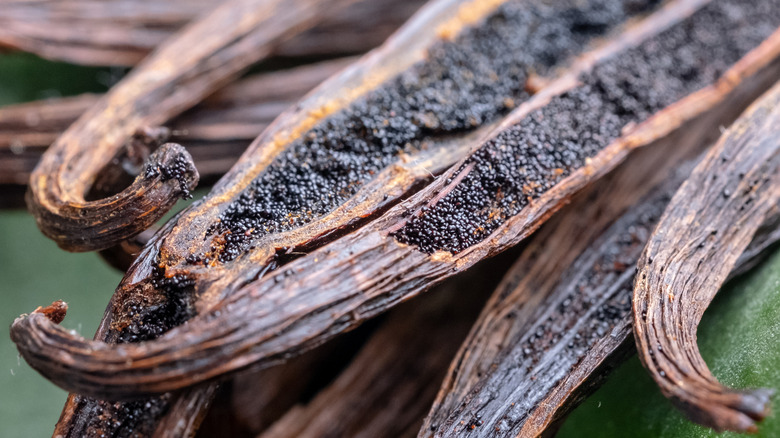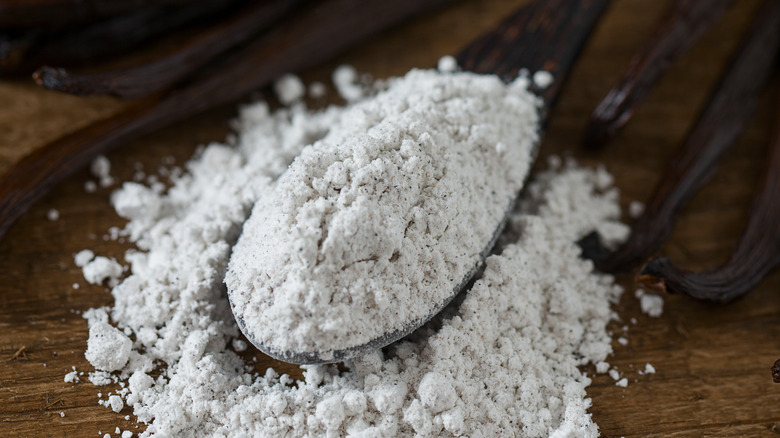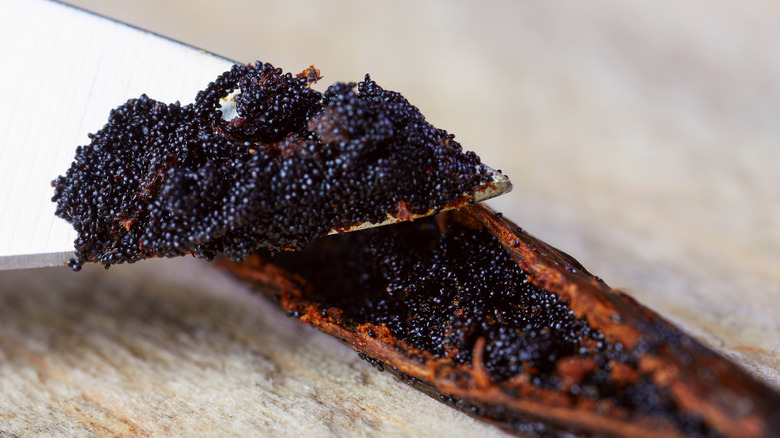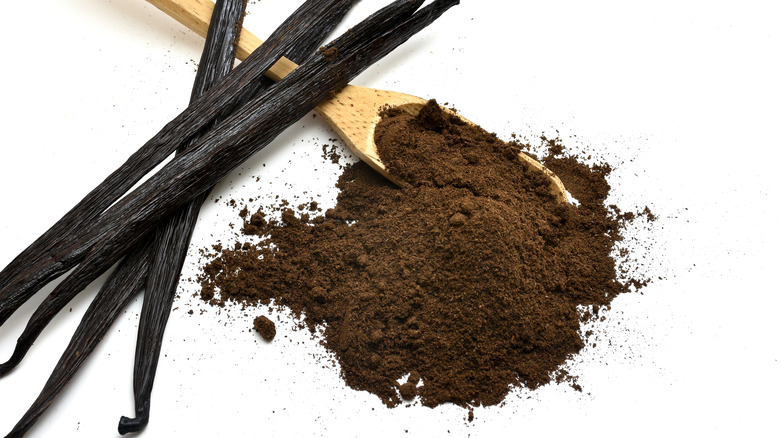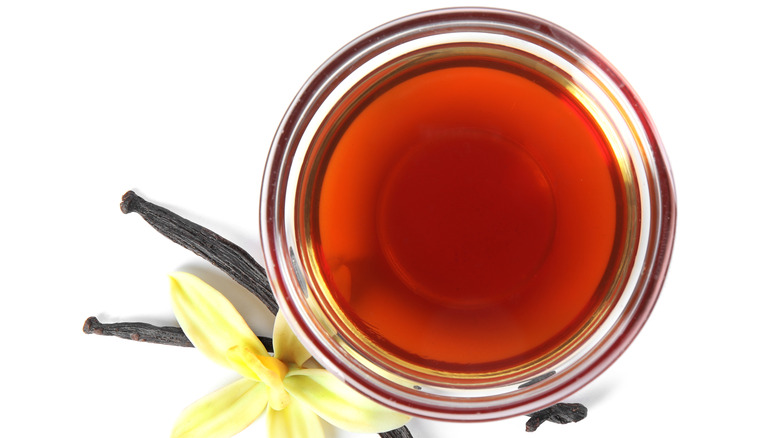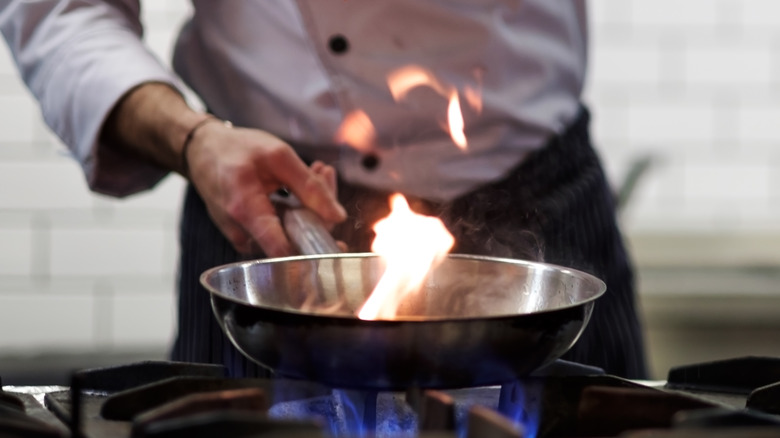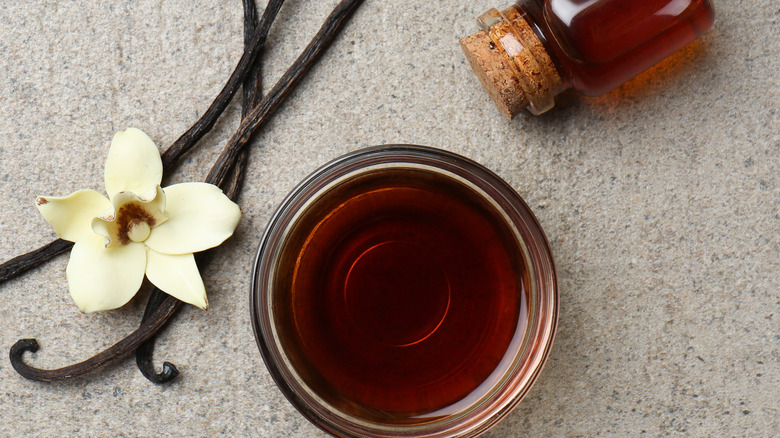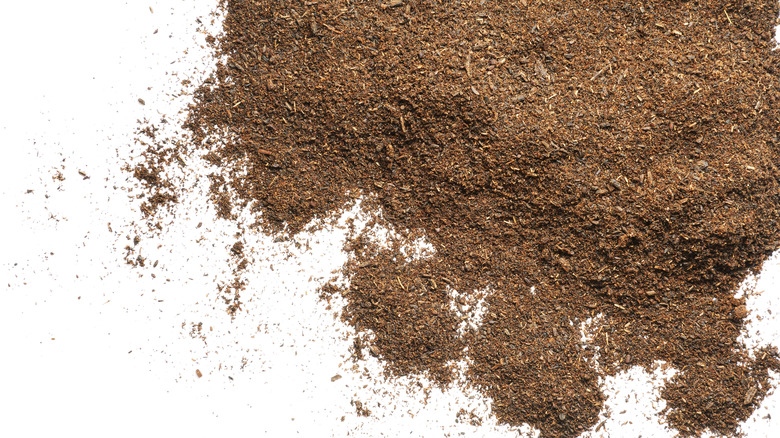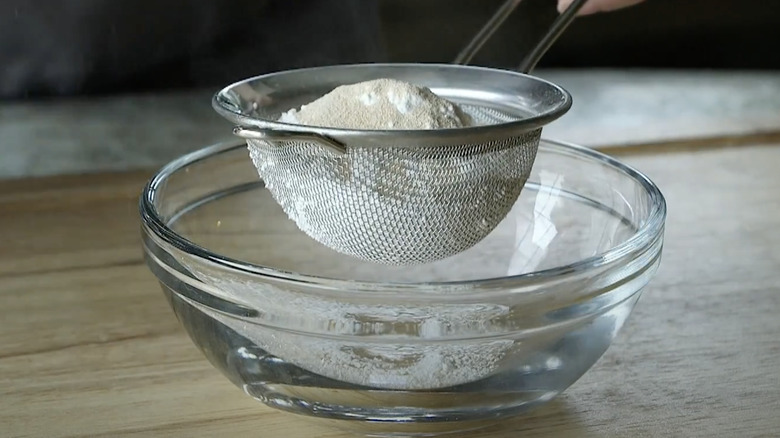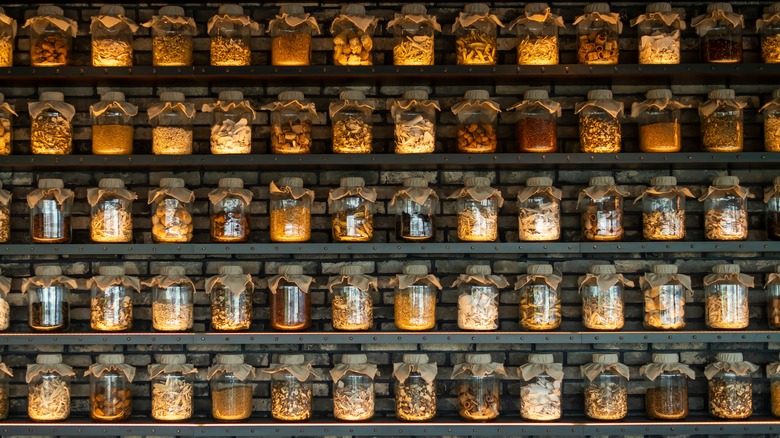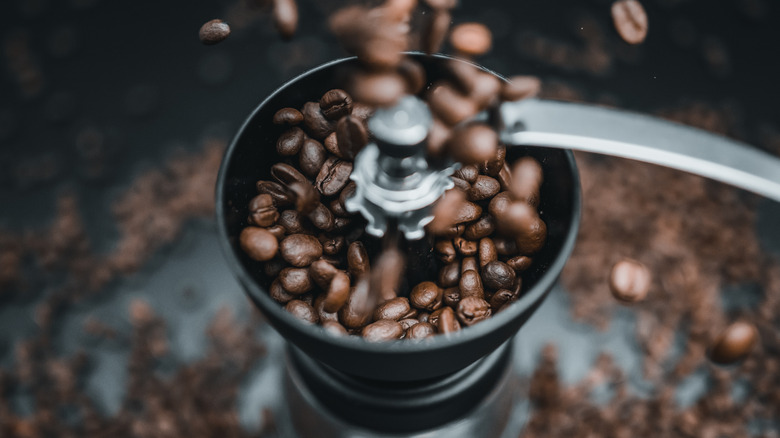What Is Vanilla Powder And Is It Better Than Vanilla Extract?
If you're curious about the difference between vanilla powder and vanilla paste, then you're probably more of a prolific baker who's already a step ahead of the rest of us who've typically just seen vanilla extract in most standard recipes. But the truth about vanilla flavor in general reveals there are many ways to add it to your dishes, both in desserts and even in savory dinner recipes. Each form tends to come with its own pros and cons.
Vanilla actually refers to an entire genus of one of the world's largest flowering plant families, orchids, and while vanilla flavor could be pulled from just about any of them, the plant that is most often used for commercial vanilla flavor originated in Mexico and is the flat-leaved vanilla (Vanilla planifolia), according to ScienceDirect. Flat-leaved vanilla most often finds its way into vanilla extract production. That may still leave you wondering what vanilla powder really is and if it's better than vanilla extract, not to mention how to use it and why. Don't worry. We've got all the answers here.
What is vanilla powder?
Okay, let's take it from the top because true vanilla powder is nothing more than vanilla in a powdered form, which will become more clear below. We've already learned that most of the vanilla we consume comes from a Mexican variety, and it turns out that the Aztec were the first known consumers of vanilla when they used it to flavor their cocoa, according to Kew Royal Botanical Gardens. And while you may have already known that saffron is the most expensive spice in the world, you might be surprised to learn that vanilla finishes at No. 2, thanks to all the work involved in the process of cultivating it.
According to Nielsen-Massey Vanillas, the vanilla orchid grows no more than 20 degrees north or south of the equator, and there are only five locations naturally growing the flower and its valuable pods today: Mexico, Madagascar, Tahiti, Uganda, and Indonesia. Vanilla's homeland is similar to the equatorial belt that coffee beans require (which is why U.S. coffee doesn't really exist). Vanilla from each region actually has subtle taste differences due to the environmental conditions, much like coffee. If you haven't tasted differences in your vanilla, that's probably because you've only been consuming the variety that appears in most supermarket products. Specifically, it's the vanilla pods (sometimes called beans) that we consume in various forms, and that includes the thousands of small, black seeds within.
How is vanilla powder made?
Since all true vanilla products come from the same source, you may be wondering how we ended up with so many varieties, and we already know you're especially curious about how vanilla powder is made, so here we go. According to Food Editorial, pure vanilla powder is nothing more than ground and cured vanilla pods. This may sound like an easy process if you've only heard of curing in reference to meat, like all those gorgeous meats on your charcuterie board. But the process of curing fresh vanilla pods is far more labor intensive than that of curing meats, with a multi-step, multi-month regimen that requires handwork every step of the way, as detailed by Cook's Vanilla.
Some bottled versions may include anti-clumping agents like cornstarch, but you shouldn't see anything else on the ingredient label if you're holding true vanilla powder. There are some other products that occasionally masquerade as vanilla powder, and we'll get into those below. For now, suffice it to say that if your ingredient label shows sugar or other sweet additions, you're holding something that isn't vanilla powder.
Vanilla powder vs. vanilla sugar
As we said earlier, not all products marketed as vanilla powder are actually vanilla powder. The main offender here is vanilla sugar, which, according to natural vanilla company Native Vanilla, is really just sugar that is flavored with the spice. Vanilla sugar certainly has its use as a delicious sweetener, but it best considered as a substitute for other uses for sugar and should not be used in place of true vanilla powder when a recipe requires this very unique ingredient.
There are no labeling standards or laws on this product yet, so you'll have to do the sleuthing yourself to determine if the vanilla powder you're holding is really just vanilla powder. If there's any sugar on the label, it's not. You'll also need to arm yourself with the knowledge that the label is unlikely to use the word sugar. Look out for maltodextrin, dextrose, or ground sucrose, but even some vanilla powders add anticaking agents like dextrose, so this also not a foolproof method. Your best clue is price. Vanilla sugar is cheap because, well, it's pretty much just sugar, while vanilla powder is considerably more expensive.
Vanilla powder vs. fresh vanilla
Finally, here are two vanilla ingredients you can easily distinguish by sight! While vanilla sugar and vanilla powder may be very texturally similar and difficult to distinguish when vanilla sugar is finely ground, fresh vanilla looks nothing like that. According to the Auguste Escoffier School of Culinary Arts, fresh vanilla refers to all of the delicious seeds within the vanilla pods themselves. You may be most familiar with this presentation in the freezer aisle of the grocery store, where vanilla bean ice cream is full of those tiny black dots that are actually vanilla seeds.
Fresh vanilla is one of the most potent forms of edible vanilla products, and it's available at gourmet grocers and specialty baking shops. If you're on the hunt for this, you're just looking for vanilla pods. To access the seeds, you'll just need to cut a pod in half lengthwise and then gently scrape out the thousands of teeny tiny seeds within. They'll come out like a paste, but don't confuse this with the vanilla paste that you may see for sale. That paste, per Nielsen-Massey Vanillas, is actually a combination of fresh vanilla and vanilla extract, and is often used by chefs who don't have the time or resources to scrape vanilla pods manually but still want the visual effect of seeds.
Real vanilla powder is brown
Because most of your favorite vanilla-flavored foods are white — ice cream, cakes, milkshakes, candies — you might expect to look for a white-colored ingredient when seeking vanilla in its most natural form. But you shouldn't. According to Singing Dog Vanilla, the actual powder is brown because it's nothing more than ground pods and seeds, which are brown and black. The vanilla flower is largely white, but the part of the plant used to make the spice is brown. At this point, you may also be realizing that the vanilla extract in your baking cabinet is also brown, and wondering why you were expecting white at all. It's okay — we were in the same boat.
This key piece of color knowledge can also help you distinguish true vanilla powder from those other so-called powders that are actually vanilla sugars. Very often, those tricky products are white or cream in color and are useful to bakers who want their end presentation to be as purely white as possible and can create their recipes accordingly, but you are now aware that this product is a sugar, not a vanilla powder, and you can't use them interchangeably in a pre-written recipe, so shop and mix carefully.
Vanilla powder is stronger than vanilla extract
Among the key usage differences between vanilla powder and vanilla extract is that the powder form is significantly stronger. By nature, an extract is automatically diluted by the alcohol and/or water content containing the flavor essence. And, since you already know that vanilla powder is purely ground vanilla, it should make perfect sense that vanilla powder packs a considerably more powerful flavor punch. According to The Kiwi Importer, vanilla powder is roughly twice as strong as vanilla extract, so you should only use half the amount of vanilla powder if you're substituting powder for extract in a recipe.
Still, we don't recommend that you substitute vanilla powder for vanilla extract in baking recipes at all. One is a solid, and one is a liquid, and using the wrong one could seriously throw off the balance of any delicate baking recipes (and pretty much all baking recipes are precise and delicate). Instead, it's best to keep this flavor ratio in mind when developing recipes of your own. This way, you can still balance the solids to liquids and keep your vanilla potency in check.
Vanilla powder is better for high-heat recipes
Some recipes cook at high heat for shorter amounts of times while others cook at lower temperatures for longer times, and neither of these is a great environment for vanilla extract. As The Kiwi Importer explains, the alcohol content of vanilla extract is prone to evaporation at especially high temperatures or over longer cooking periods. Since vanilla extract is especially high in alcohol content, that means much of the product will evaporate in either of these conditions, leaving you with minimal vanilla flavor. In both of these conditions, vanilla powder is going to be the better bet for maintaining a strong vanilla flavor throughout the cooking or baking process. And in case you're thinking that sounds like every recipe, consider that many recipes for baked good like cakes and cookies bake at an average temperature and for shorter periods of time, so there are still tons of uses for vanilla extract, which is precisely why it's so common.
If you're now a bit alarmed to learn that there really is alcohol in vanilla extract and are suddenly wondering just how much, ABC News reports that the minimum alcohol level required by the FDA for pure vanilla extract is 35%, which makes it the same proof as Captain Morgan rum. So yes, if you could stomach shots of vanilla extract, it would be equivalent to taking shots of some pure liquors, leaving plenty to wonder why it can be sold without age restrictions.
Vanilla extract brings out other flavors better
To be clear, it's vanilla in general that seems to bring out some other flavors in recipes better, and there are a couple of reasons for that. According to Prepared Foods, the primary reason it heightens the flavor of fruit-forward and dairy dishes is because it reduces the acidic notes of those ingredients and leaves behind the sweetness and the creaminess that we primarily associate with them. Because more gourmet vanillas come from regions outside of Mexico, some of them may carry different tasting notes from their terroir that will also complement or enhance other flavors of the recipe, as wine does with various dishes.
Specifically turning to why vanilla extract tends to do this better than vanilla powder, this one isn't as complicated or technical as it may seem. You may recall that vanilla powder is twice as potent as the diluted output of vanilla extract, which also tends to evaporate the longer or higher it's heated, reducing the vanilla flavor even further. As vanilla powder brings so much more vanilla flavor and none of it cooks off, so to speak, the finished product is far more vanilla forward, leaving less room to round out a recipe's other ingredients. In some cases, vanilla powder may even overpower other flavors, which is why it's ideal when you simply want a vanilla-flavored treat.
Vanilla powder nutritional information
Vanilla is a food item we turn to solely for flavor, and that is true of all its forms, so you shouldn't look to vanilla powder in search of a ton of nutritional benefit. It's a spice, not a source of substantial nutrition. That said, it's also not bad for you. Vanilla powder receives a B+ rating from My Net Diary and contains 20 calories and 0 grams of fat per teaspoon. Keep in mind you're not even likely to use a full teaspoon of potent vanilla powder in a single recipe, either. For obvious reasons, pure vanilla powder is far lower in sugar and calories than vanilla sugar, but don't forget about all of those vanilla sugars disguised under the name of vanilla powder if these nutritional considerations are relevant to your selection.
Nutrition aside, there are some other potential health benefits that vanilla may offer. As Healthline explains, the vanillin found in vanilla beans may offer antioxidant properties and have anti-inflammatory benefits. It may also promote brain health and help prevent neurodegenerative diseases. There is little science to back up these claims, so we don't recommend building a health regimen around vanilla powder, but that doesn't mean vanilla doesn't have any benefit beyond flavor, at least to some degree.
How to use vanilla powder
As we've already discussed, vanilla powder is not a great substitute for vanilla extract in a recipe. Even if you cut the measurement in half due to its double potency, vanilla powder is a dry ingredient, and that can have a considerable effect on the outcome, especially if you're baking (which you probably are if you're looking for a vanilla extract substitution). It also just doesn't make good economic sense to waste expensive vanilla powder on a recipe that was built for less expensive vanilla extract, so why waste the dough when the results won't even be great? Don't.
There are plenty of uses for this premium ingredient, though, and those extend beyond gourmet recipes. WebMD recommends using vanilla powder in place of sugar if you're trying to cut back on sugar intake as part of a healthier eating regimen. If you're going this route, be sure you don't mistakenly purchase a vanilla sugar labeled as a vanilla powder, or you'll completely derail your objective. More specifically, because it dissolves so easily, Lone Goose Bakery recommends using vanilla powder to flavor drinks like your morning coffee so you can skip adding sugar to your sips. And if you do end up cooking with vanilla powder, Slofoodgroup suggests blooming it first. That simply means soaking it in one of the recipe's liquid ingredients to open up the inherent flavors before adding it to the mixing bowl.
Where to buy vanilla powder
Hooray! You're sold on the idea of using vanilla powder, but now you need to know where to actually buy it. Unfortunately, because of its rather specific uses and high price compared to cheaper alternatives like the more readily available vanilla extract (which is already not cheap), you're not necessarily going to find vanilla powder in standard grocery stores. We promise it's worth a little added effort to track down vanilla powder, though, so don't be daunted.
Gourmet Sleuth advises that vanilla powder may be found at specialty retailers, local bake shops, and gourmet ingredient stores in your neighborhood. Otherwise, thanks to the glorious times we live in, you can certainly shop for pure vanilla powder online, either straight from the producers themselves or on popular shopping sites like Amazon. As with just about anything else today, it's there, but don't be tricked by cheap alternatives that aren't pure vanilla powder. We know we've said this many times, but it's critical to be sure you're getting real vanilla powder. This isn't like the difference between organic and non-organic; real vanilla powder and its mislabeled alternatives are not even the same food item.
How to make vanilla powder yourself
Despite our countless warnings, we promise it's not impossible to locate and secure real vanilla powder, even if you've never shopped for it before. Still, if you're having difficulties, you can make vanilla powder yourself. It'll take a bit of specialty equipment and some time, but you may already have everything you need, aside from the vanilla pods themselves. Securing those is, of course, the first step.
Once you have vanilla pods in your possession, Foodtasia confirms it's quite easy to whip up your own homemade vanilla powder, and it's considerably less expensive that buying it. First, you'll need to further dry your beans (that's an extension of the curing stage we mentioned earlier), and you can do this by baking them at very low heat for an hour or higher heat for a few minutes. A microwave works, too. You can also leave them sitting out for a couple of weeks. It's important not to burn the beans, which is why you have options that include less heat, or even none. Once they're dry, all you need to do is grind the beans as fine as possible. You'll want a coffee grinder or spice mill to handle the job. A food processor isn't going to leave you with a nice, smooth powder, so you do want one of these dedicated gadgets to get the job done properly. And that's all there is to it.
